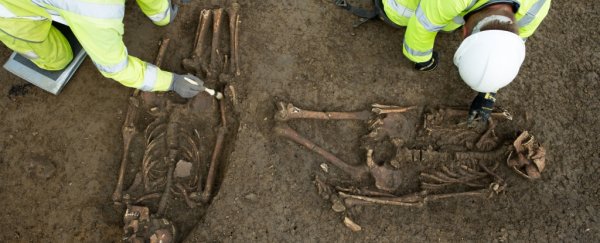Archaeologists excavating the site of a future highway have found a very unusual ancient burial: the skeletons of two men, with smashed skulls, and both legs chopped off at the knees. They were buried with their amputated legs next to their arms.
The bodies are among the latest in a long list of discoveries during excavations ahead of construction for the improvements to the A14 Cambridge to Huntington highway in England.
"Somebody really, really didn't like these guys," said Jonathan House, an archaeologist with Mola Headland Infrastructure, told The Guardian.
So far, Mola Headland Infrastructure's discoveries span 6,000 years of human history, with particularly interesting finds from the Roman era.
The two skeletons haven't been studied yet, but they date back to either the late Roman era, or the early Anglo Saxon period, from about the 5th century.
They were found buried at right angles to each other in a T-shape, their heads pointed away from each other, with the dismembered lower leg bones by their sides. Both skulls were significantly damaged, but it's too early to tell whether that was caused prior to death, or whether they caved in over time.
The location of the burial was a gravel pit being used as a midden. It's difficult to determine whether violence was inflicted on the men, or whether they were simply repositioned after a natural death, but so far the evidence points to something quite unpleasant, archaeologists say.
"Was [the amputation] to keep them in their graves and stop them from running away?" Cambridge County Council senior archaeologist Kasia Gdaniec said. "Or had they tried to run away and was this a punishment - and a warning to everyone else not even to think of it?"
Another body was found 50 metres (164 feet) away. Or rather, a torso was found - there was no sign of pelvis or legs. It had been tossed into a Roman well that was already being filled in; based on the position of the bones, the torso was intact when it was thrown in.
"People talk about the archaeology of conquest, but I have never felt it as strongly as here," Gdaniec said.
"The Romans arrive, the people who were here are completely subjugated, everything changes and is never the same again. We are not seeing trade and peaceful co-existence here, we are seeing enslavement."
The site shows no signs of large, permanent Roman buildings, so the team believe that it was used as a temporary camp, used by Romans marching north to Hadrian's Wall.
It also yielded 40 pottery kilns, and evidence of intensive farming. It's possible that this was a Roman supply farm, and that it was worked by slave labour. A detailed analysis of the bones, including dating and isotopic analysis, should reveal more about the men and how they died.
Other extraordinary finds from the over 350 hectares excavated include three prehistoric henge monuments, 12 abandoned medieval buildings, a large Roman trade centre, prehistoric burial grounds, a prehistoric ear stud, and Anglo-Saxon settlements.
